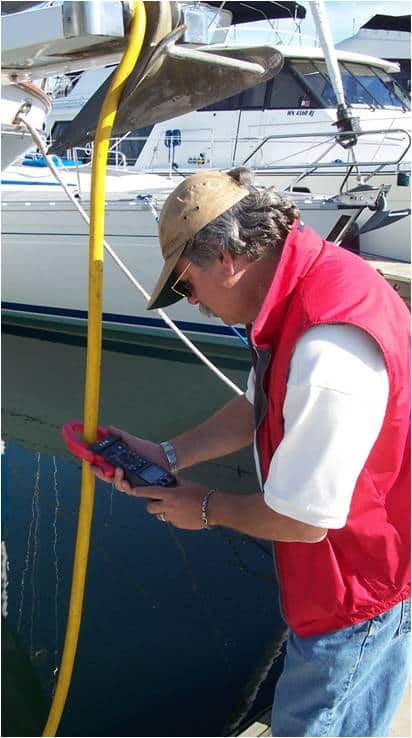
shore cord check_3696.jpg
Electrical current that is.

To the uninitiated the photo above hows me doing something with a clamp-on ammeter that is counter to what most folks have been taught to do with said tool. In general, when you are measuring amperage flow through a conductor you only want to clamp around one wire. In the situation above I’m clamped around the entire shore power cord to the boat in question, and there are three individual wires, or conductors inside that yellow insulation.
So the question is, what the heck am I doing? Well I’m looking for leakage current or what is sometimes referred to as residual current.
You see with alternating current, which we’ll call AC here, the current flow is really in two directions, it is alternating. The important thought to keep in mind is that it must cancel itself out. In engineering terms we call this a “sum zero” situation. That is if all is well with your boat. In the situation above, any reading I get with my ammeter set to the AC amp scale is telling me that some amperage is leaking and not being returned to its source. In a perfect world, I should get a reading of zero amps the way I’m measuring things above. Well, as most of us know at this point in our lives it is far from a perfect world and I’m actually reading 1.6 amps of leakage current on the above cord. The question becomes where is the current going? Answer, probably in the water surrounding the boat. Why you ask? Because if the boat is built according to ABYC standards the AC and DC grounding systems are connected together at the back of the boat’s electrical panelboard.
Now, if the boat has a bonding system, which means tying all the underwater metal objects like bronze sea cocks, rudder posts and strut mounts together electrically via a green 8 AWG wire or copper strap, then these bits of metal are all tied to the boat’s DC grounding system, and in turn the AC grounding system. What this means in a nutshell is that if there is an AC leak from an AC appliance it ultimately ends up exiting the boat, at least in part, via the underwater through hull fittings as it tries to find a path back to its source. Of course if the dock grounding system is in good shape some of the leakage current will follow that path back to the source. The sad truth is, many of the dock grounds are not in good shape so the alternate path is in the water at the marina.
If a swimmer enters into the current path in the water around the boat, they are going to get shocked, and unfortunately, they might not survive it. That all depends upon the actual amount of current they get run through their heart. All of this is what has lead the ABYC to adopt a requirement for a new device that is known as and ELCI, acronym for electical leakage current interrupter. I’ll be talking more about those in upcoming installments here.
What got me going on this installment is that several days ago I heard of a boat builder who is having some rather perplexing problems with one of their new boats with the ELCI device installed in their shore power system. Seems it keeps nuisance tripping and shutting all the power off to the boat every time they turn on the battery charger….
This is an interesting problem because international electrical standards clearly dictate that, depending on the category of appliance, the maximum allowable leakage current should not exceed 0.01mA to an absolute maximum of 0.075mA. ELCI devices are engineered to trip out at 30 mA nominally. So, this is a really intriguing problem that we have not fully sorted out just yet, but hope to figure out over the next few days.
As for your own boat, I’m asking you to check it out on your own. Keep in mind that 1 amp of AC through someone’s heart will kill them. Also keep in mind that normal leakage current from the various appliances on your boat is cumulative so getting some reading on your meter above zero is to be expected. Ideally we would like to see it below 5 mA.
The Blue Sea amp clamp that I discuss in Eds Tool Box here on the site is reasonably sensitive on the AC scale and although it does not have the resolution to measure milliamps or fractions thereof, it can get you down to fractions of amps, meaning that any reading you get on that meter is in the 100mA + range.
If you are using the Blue Sea clamp on your shore cord, and remember the best way to take this measurement is to one by one turn on your AC appliances and see if the reading changes.. If you get any reading on the Blue Sea meter, it is a potentially lethal reading. You must get the appliance in question checked out and either repaired or replaced. Common sources of excessive leakage current of boats are: electric water heaters, old battery chargers and electric ranges. If you get a reading imediately that keeps going up as you turn on appliances on your boat, then the boat may have what we call a “false ground” whereby there is a neutral to ground connection at either the panelboard or at an appliance that should not exist. Get a MARINE electrician to check this out. Its a fairly common problem that is usually the immediate result of someone having a land based electrician work on the boat.
Remember that 1 amp equals 1000 milliamps (mA)and that can be lethal. Try it on your boat. You might just save somebody’s life. Remember swimming around docks and boats in a marina is a very dangerous endeavor and should be avoided.







